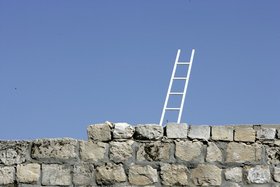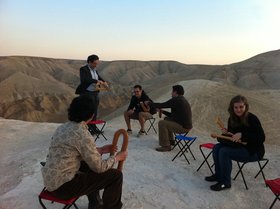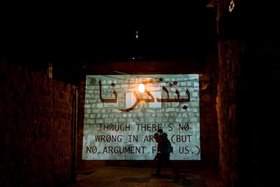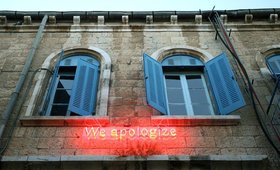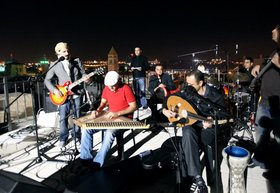Interviews
The Jerusalem Show
Jack Persekian in conversation with Basak Senova
Jerusalem-based Jack Persekian is the curator of The Jerusalem Show, which was launched in 2007 with the Al-Ma'mal Foundation to present works, performances and interventions throughout the Old City. Showing works by mostly Palestinian artists, the exhibition functions as an attempt to re-read and re-negotiate a city torn apart by conflict. In this interview, curator and writer Basak Senova talks to Persekian about the genesis of the exhibition, the obstacles and practical issues inherent in staging an exhibition in a contested site, and the importance of improvization and contingency for the continuation of the event.
Basak Senova: As I observe it, the Old City of Jerusalem was not chosen as a mere location for the event, but as 'the setting' for The Jerusalem Show, structuring the event according to its own cultural, social, and political dynamics. What does it mean to have this event in the Old City of Jerusalem?
Jack Persekian: Jerusalem is the epicentre of the Palestinian existential struggle for self-determination and statehood. Since the Oslo Accords – where we saw the Palestinian delegation relinquish all rights to Jerusalem to the Israelis – Jerusalem has been gradually usurped by the Israelis (particularly the settlers), leaving its Palestinian inhabitants totally cut off from their families and friends in the West Bank and Gaza, and from the rest of the nation. Eventually, with the building of the separation wall, the city will be literally amputated from its natural extension into the West Bank. So insisting on working in Jerusalem and organizing The Jerusalem Show is a sort of act of resistance to the forced hegemony and control of one nation and one creed on the city.
BS: In view of that, the whole event, which covers a range of interrelated issues, operates as a potential communication tool, functioning like a two-way radio, simultaneously transmitting and receiving information.
JP: The Jerusalem Show provides us, the local inhabitants of the city, with the means to have our voices heard, our dreams and aspirations expressed, and our misfortunes and pleas considered. It also provides the opportunity for visiting artists and guests to discover what life in Palestine and in Jerusalem in particular is about, and to possibly engage with it. The visiting artists and guests on their part would become our ambassadors in the world after having had the experience of being here, not merely as observers of the situation but as people who were implicated, got involved and engaged with the country and its people.
BS: While referring to the current political and social situation along with the Palestinian struggle, what are the obstacles that you impulsively experience and also expect from the visiting artists and international guests?
JP: Obstacles are numerous, starting from the unpredictability of a guest being granted a visa to enter the country as she or he flies into Ben Gurion airport to the ridiculousness of getting around between Jerusalem and the West Bank due to the checkpoints and the fragmented geography. There is also the absurd situation visitors find themselves in with regard to the relations with the Israelis. On one hand, the international visitors would want to go over to the Israeli side to see and meet people, while on the other there are absolutely no relations between the Palestinians and the Israelis to help facilitate that. This makes the whole situation all too awkward and confusing to many who are visiting from abroad and are not well informed about the conflict and its intricacies.
BS: At the same time, it gives possibilities for international interventions and projects. How do they communicate with the local context?
JP: Most of what we do and present is basically inspired by and, in one way or another, a response to the local context. That's why we always insist that the artists taking part in the show come to Jerusalem at least once before they decide what they want to do for the show – given, of course, that we have sufficient funds for it. Another very important element constituting a cornerstone for the show is the fact that the artworks, the projects and the interventions, are spread out in different parts of the city and are developed with the several partner institutions we work with for the realization of the event. As a result, the work presented is the outcome of an engagement and a relationship with the art community in the Palestinian territories, the institutions who have partnered with us on the project, and the public at large.
BS: How is The Jerusalem Show received by the local audience?
JP: I think the local audience is aware of the capabilities of art and its potential to open up to other cultures and experiences. They're also well aware of the opportunity such events like the The Jerusalem Show can provide in terms of freedom of expression and knowledge production. Yet the weight of this complex situation on their day-to-day lives and the extreme difficulty in negotiating and navigating the simplest of day-to-day chores under occupation, pushes art initiatives such as ours to the background, becoming sort of secondary to the more pressing issues of life. One feels as if we're living in survival mode. Hence, at the Al-Ma'mal Foundation, we are fully aware that we won't be able to change the general perception of the people and the world in general but we think we are able to introduce pockets of resistance to prevalent and dominant perceptions.
BS: Could you describe the operational structure of The Jerusalem Show?
JP: You have to keep in mind that The Jerusalem Show is a low-budget event with humble means. Hence, the whole operational structure depends mainly on a couple of people working at the Al-Ma'mal Foundation, in addition to a couple more we hire for a specified period of time, and a lot of goodwill and volunteers who help out with the operation.
BS: What is the procedure to appoint the curators? Is there an advisory or executive board for the show? How do the curators select or commission projects? What is the balance between the new productions, commissioned events and existing works?
JP: I basically make most of the decisions with regard to appointing curators and agreeing with them on commissions and the programme in general. Again, as this is a low-budget event, we try to work with artists on the most interesting and feasible way (given our means) to present their work. Much of the time it is a combination of existing work and works that get produced here in Jerusalem. From past editions of The Jerusalem Show, I can say that the percentage of existing versus commissioned works is 50/50.
BS: Could you name and explain any local (political, social, economic, or cultural) constraints that affect the content and/or the production processes behind the works?
JP: Where do I start? The local (political, social, economic and cultural) context has a major impact on the work produced and presented, and as I mentioned before, our situation is disastrously plagued with impediments and tragedies. Politics is everywhere and features extensively in the work, less so the social, economic or cultural context. Politics is a fertile ground for artists to draw ideas and topics from. So in this framework, I think that politics is no constraint; on the contrary it provides an abundance of issues and concerns to deal with, address, or at least take a position on. Yet being in Jerusalem with no relations whatsoever with the authorities makes life and (in our case) the production and presentation of works of art in the city quite complicated and limiting. Confined to private venues, with no access to public spaces whatsoever, the event can be perceived as an underground and even subversive act.
BS: There is a special emphasis on the live performances and sound-based works in the The Jerusalem Show. Why are they inspiring and instrumental to the event?
JP: Can I answer that it's simply my personal interest and passion? Nevertheless, I truly believe that the local art scene does not yet properly consider these alternative genres and explore their potential and so I would like to do something about it. I think the horizon it opens for art practices in the Palestinian territories is crucial for its development and evolution. I also believe that this interdisciplinary approach is liberating, offering a diverse palette of mediums and references to draw from and connections to make, in stark contrast to our controlled, disconnected and segregated environment.
BS: In the same vein, how does 'improvization' intertwine with the scope of The Jerusalem Show?
JP: Improvization is a crucial modality for breaking the potential regularity of the show, which comes as a direct and practical urge to take shortcuts and align things in uniformity and in light of the multitude of limitations and constraints. I always believed that in such a complex situation, to be true to the context, one shouldn't simply put up a show that is conformist and linear. Improvization is paramount to negotiating obstacles, transcending barriers and survival in this unpredictable, shifting and volatile environment. Improvization is also a way to keep returning to the core issues, yet every time with new thought patterns, new practices, new structures or symbols, and new ways to act.
Jack Persekian is the founder and director of Anadiel Gallery, the Al-Ma'mal Foundation for Contemporary Art in Jerusalem and XEIN Productions. He acted as Head Curator of the Sharjah Biennial (2004–2007), Artistic Director of the Sharjah Biennial (2007–2011), and Director of the Sharjah Art Foundation (2009–2011), Artistic Director of Darat Al Funun, The Khalid Shoman Foundation, Amman, Jordan (2012). He has recently curated exhibitions such as Disorientation II (Manaret Saadiyat, Saadiyat Island, Abu Dhabi 2009), Never-Part (Bozar, Brussels, 2008), Dubai Next (co-curated with Rem Koolhaas at Vitra Design Museum, Weil am Rhein, 2008), The Jerusalem Show (Al-Ma'mal Foundation, Jerusalem, 2007 to present day). He has also directed and produced a series of short films and videos, including Outside the Gates of Heaven (2012), Sharjah Biennial 9 (2009), Forgive and Forget (2008), and My Son (2005). He lives and works in Jerusalem.

